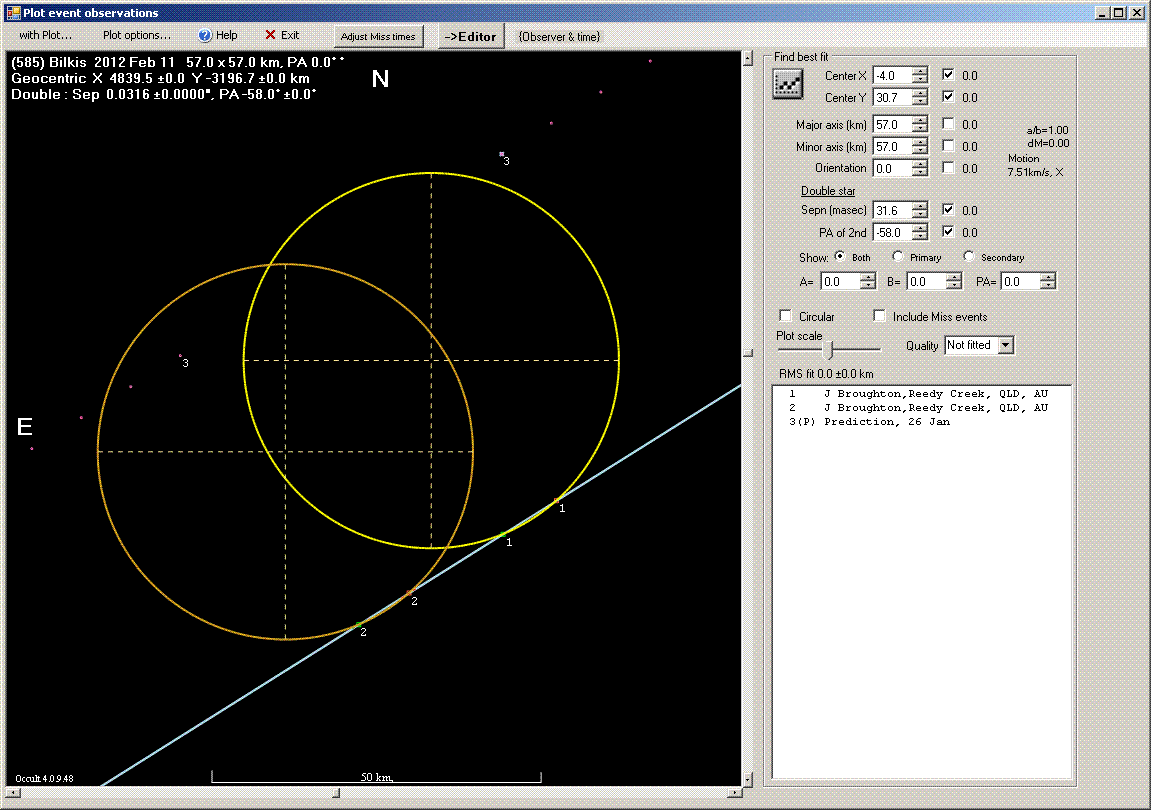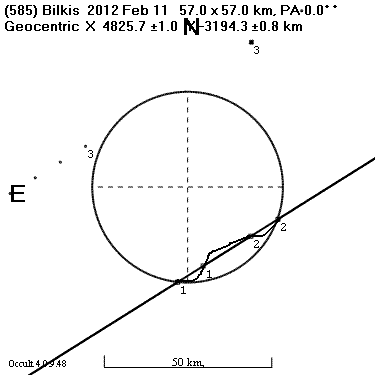|
|
Two, just over 1 second occultations were recorded from the same telescope by John Broughton, using video OSD technique.
View the updated prediction.
Observers:
1 J Broughton,Reedy Creek, QLD, AU
2 J Broughton,Reedy Creek, QLD, AU
3(P) Prediction, 26 Jan

Discussion:
The circle above is plotted at the expected 57 km diameter of Bilkis.
The two events could indicate as shown above a double star with separation
of 36.1 milliarcseconds and PA of 58 degres. But that is alsmost exactly
along the line of the chords and the stars have very similar magnitude. The probability of this is small.

The other possibility is that we have a grazing event of an object with two lobes
that resulted in 2 equal length dips. Again the probability is small.
Unfortunately there are no Damit or ISAM 3D models that could be used to see
if the shape and orientation could support this option.
On the balance of probabilities it seems slightly more likely that the second option is is the right one, however in either case with these chords from only one site it is not possible to determine whether John was north or south of the central line of the event so the astrometric location will show the chord centered on the object.
The figure below shows the light curve of the occultation.

Observational Data:
Observation details for MP ( 585 ) Bilkis
By Star TYC 0239-00706-1
On 2011-02-11 at 18:02:41.0
_______________________________
Observer John Broughton
Location Reedy Creek, QLD, AU
Longitude +153:23
Latitude -28:06
Altitude 66 m
Datum WGS84
Telescope SCT including Cass and Mak
Aperture 25 cm
Seeing Steady Clear
Camera Type WAT120N PAL/CCIR
Camera Delay 0.09
Timing GPS - time inserted Video with frame analysis
Disappearance 18:02:39.43
Reappearance 18:02:40.71
Comments: This appears to be a graze involving two 1-second disappearances
within the predicted duration.
D= 18:02:39.43 R= 18:02:40.71 D= 18:02:42.31 R= 18:02:43.43.
_______________________________
Observer John Broughton
Location Reedy Creek, QLD, AU
Longitude +153:23
Latitude -28:06
Altitude 66 m
Datum WGS84
Telescope SCT including Cass and Mak
Aperture 25 cm
Seeing Steady Clear
Camera Type WAT120N PAL/CCIR
Camera Delay 0.09
Timing GPS - time inserted Video with frame analysis
Disappearance 18:02:42.31
Reappearance 18:02:43.43
Comments: This appears to be a graze involving two 1-second disappearances within
the predicted duration.
D= 18:02:39.43 R= 18:02:40.71 D= 18:02:42.31 R= 18:02:43.43.